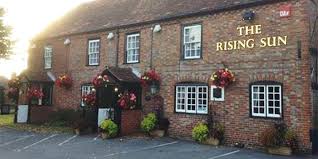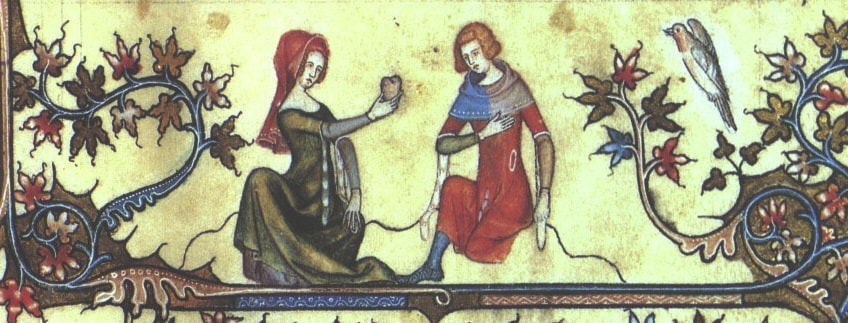Hmm. That sounded slightly exotic to a very young little girl living in Laramie, Wyoming. Not long after this, Hal, (my brother) got a new guitar and he gave me the older one as a bribe to clean up my room. (it worked.) But I needed to learn how to play this beautiful song. Hal was a self-taught guitarist, and believed that I could be, too. So, he just gave me the chord charts, and the order to play them in and let me be.
My little hands were just too small to form most of those chords. To help out, my dad gave me a couple of books of folk songs and easier ways to play some of the chords. I was about 9 when, in a new book of folk songs, I found music to House of the Rising Sun. And there were words! Who knew!?!?
I was thrilled with this discovery. As I learned how to sing the song, I thought that it sounded vaguely familiar, but assumed that I’d just heard Hal sing it a few times. The lyrics were evocative. I built a story around them. (These are the words that I learned when I was 9. You may know different words. This is, after all, a folk song.)
There is a house in New Orleans
They call the Rising Sun.
It’s been the ruin of many-a poor girl.
And, God, I know, ‘cause I’m one.
If I had a-listened to what Mama said
I’d be at home today.
But I was a young a foolish poor girl;
I let a gambler lead me astray.
My mother, she’s a tailor,
She sews those new blue jeans.
My sweetheart is a drunkard, Oh Lord,
He drinks down in New Orleans.
Go tell my baby sister,
Don’t do what your sister done.
Stay away from that house in New Orleans
They call the Rising Sun.
With one foot one the platform
The other on the train,
I’m going back to New Orleans
To wear that ball and that chain.
I’m going back to New Orleans,
My race is almost run.
I’m going back to spend my life
Beneath that Rising Sun.
In my young and naive version of this story, there is a young woman who fell in with a bad crowd. After all, her sweetheart is a drunkard and a gambler. He led her astray, into a life of crime. And she’s been in jail, a jail they call the House of the Rising Sun. She’s gotten out, but now they need money. In their need, they do something wrong: maybe even rob a bank. She’s been caught, and she’s going back to New Orleans to spend the rest of her life in the House of the Rising Sun: jail. It makes sense – right?
Where does the song come from?
Now, House of the Rising Sun is a folk song. We do not know who wrote it or when. It may even go all the way back to England. It does have a lot of similarities with some English folk songs. Instead of taking place in New Orleans, one of them takes place in Lowestoft in England. There are several books and articles that try to make House of the Rising Sun an offshoot of the 16th Century ballad The Unfortunate Rake. And while there are some similarities to The Rake; House, and other songs like The Streets of Laredo, (which shares a melody with The Unfortunate Rake) are all lament songs, a specific type of folk song that share some similar elements without being any closer related.
The first mention of House of the Rising Sun that I was able to find, was in 1937. Alan Lomax was working for the Library of Congress, driving around the Appalachian mountains, talking to people in remote little hollows, and recording the music that these people were playing. The thought was to save some of the mountain music before it was lost forever. Lomax was in Middlesboro, Kentucky when he heard about a young woman named Georgia Turner and a song she loved to sing. During an evening of music, Georgia sang her song and Lomax recorded it. The melody is similar to what we have become used to in The Animals recording but is still different. I have read that she sings it in a major key while The Animals recorded it in a minor key. (Think happy sounding as opposed to sad sounding.) But I don’t think the truth is quite that simple. She is singing the song in a different type of scale, called a mode. Not major, or minor, just different.
The song quickly turned up in other people’s repertoires and began to be commercially recorded. The first commercially-available recording was done by Clarence Ashley. (I admit that I had a difficult time listening to these. I tend to like my singers to be able to sing on pitch. Silly me.)
Country music great Roy Acuff recorded House of the Rising Sun in 1938, still in a major-ish key, with some different verses. In the early 1940s, Woody Guthrie recorded his take on our song.
Some people think that House of the Rising Sun grew out of the African American blues school of music. There just really isn’t much to support that. Given where the song started, and how it was sung in the early days, all roads lead to Scotland and England, even if we can’t seem to find the missing link. However, it took an African American singer named Josh White to take the song in 1941 or 1942 and put it in that sad minor key. In his guitar work, I can hear the beginnings of what would become that strumming pattern that I love so much.
The Weavers, possibly the gold-standard for folk music in the late 1940s through to the early 1960s, did their own version of House of the Rising Sun. It is a lovely, sung by Ronnie Gilbert. Now we have the minor key that White would start. The song is starting to sound more like what we are used to.
The distance from Woody Guthrie, and The Weavers to Bob Dylan is a short one, but there was an intermediary. His name was Dave Van Ronk. Dave was a bigwig in the Greenwich Village folk scene in the early 1960s. He had a version of House of the Rising Sun that follows the chord progression used by The Animals a few years later. (I freely admit that I had to struggle to even make it through even the first verse. I expect my professional singers to be able to carry a tune given a large-enough bucket. There may be an important part of folk music that I just don’t get.)
As the story goes, Bob Dylan heard Van Ronk perform the song in Greenwich Village. When Dylan was working on his first album, (which was released on my first birthday!) in 1962, he decided to record House of the Rising Sun a la Dave Van Ronk. Unfortunately, he neglected to ask for Van Ronk’s permission. Dave was more than a bit annoyed, because he was going to put the song on his next album, and now it was going to seem that he was copying Dylan instead of the other way around.
1964 brings us to The Animals and what many people feel is the definitive version of House of the Rising Sun. I have sheet music for the song, and the writing credit goes to Alan Price. This used to confuse me, given that I also know that we don’t know who wrote the song. What happened was this: the band was trying to decide who to put on the record as the arranger. All five members of The Animals had contributed to the arrangement, but there was not room on the single for all their names. Alan Price was the keyboardist, and somehow his name ended up alone on the record. This would not have been a problem, except that when it came to royalties for the sheet music, all of them went to Alan Price.
While Price may have gotten royalties for his organ playing on the record, for me it is Hilton Valentine’s guitar work that makes the song. (Yes, I love Eric Burdon’s vocals, but remember, I loved the song for the guitar part first.) He took the chord structure that Van Ronk and Dylan had established, but rather than just strum the chords, he gave us that haunting arpeggio pattern.
Their record producer had not even wanted them to record the song. But since recording it took only 15 minutes, he went along with it. Also working against the record was the fact that in the world of the 2-3 minute pop-song, House clocked in at about 4.5 minutes. While there was a shortened version that initially hit the air-waves in the US, eventually the full song took over.
For my 11th birthday, I got to pick out a new guitar. This involved driving somewhere in the realm of an hour, to get to the closest music store. I was so excited. We got to the store, and I began browsing. The clerk went to my parents, who explained about my present. So, he came over, and began, in a very condescending manner, to tell me about the parts of the guitar, and how to hold it. I finally got him to hand me the one I was interested in. After checking that the neck was straight, I started playing House of the Rising Sun. I hope he learned a valuable lesson that day: don’t be a condescending jerk!
But, my favorite part of my story about House of the Rising Sun comes a little later that year. As the school year was winding down to a close, it was announced that my 5th grade class would have a talent show. I was so excited! I knew exactly what I was going to do. I couldn’t wait to tell my mother. I raced out of school and bounded into the car and told her about the talent show. “How nice. What do you think you might sing?” “I’m going to take my new guitar and play and sing House of the Rising Sun!” “No, you’re not.” I was devastated. I begged, I cried, nothing helped.
The trip home had seldom seemed so long. I ran out of the car, and hid in my room, sobbing loudly. (I almost never sobbed quietly; I admit.) The situation remained like this until my dad got home from work. He came in, calmed my mother down, and then came into my room to calm me down. Choking back tears, I told him about my heartbreak. He had an odd suggestion. He wanted me to go into the living room and explain to my mother what the song was about. I thought this was nuts. How could she not know? (Remember my bank robbing story from earlier?) But I went in and told her my take on the song. I remember Dad looking a bit smug. Finally, she agreed that I could sing the song, but I had to explain to the class what it was about first. I thought that was a little weird, but if it would get me performing the song, then I was ok with it.
It was decades before I found out that most people think the song is about a brothel. I get it, but I still think my version has possibilities.
Do you have a story about House of the Rising Sun? Which is your favorite version of the song? Let me know in the comments below. I’ll be playing some of my favorite version of House of the Rising Sun on my Minnich Music FaceBook page this week, so be sure to check them out.
Until next time!


 RSS Feed
RSS Feed